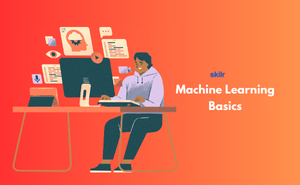👇 CELEBRATE CLOUD SECURITY DAY 👇
00
HOURS
00
MINUTES
00
SECONDS

At its core, Machine Learning Basics is about teaching computers to “learn” from data. Instead of coding every rule by hand, we provide data and algorithms that allow systems to spot patterns and improve over time. For instance, an app predicting house prices or suggesting your next favorite movie works through machine learning. These systems adapt and get smarter as more data becomes available.
Gaining knowledge of machine learning fundamentals gives you the ability to understand how machines make predictions and classifications. It explains essential techniques like training and testing models, preparing datasets, and interpreting outcomes. By learning these basics, individuals build a strong foundation to explore artificial intelligence, big data, and advanced predictive analytics across multiple fields.
This exam is ideal for:
Domain 1 - Introduction to Machine Learning
Domain 2 - Types of Machine Learning
Domain 3 - Mathematical Foundations
Domain 4 - Data in Machine Learning
Domain 5 - Machine Learning Algorithms
Domain 6 - Model Training and Evaluation
Domain 7 - Machine Learning Tools and Libraries
Domain 8 - Applications of Machine Learning
Industry-endorsed certificates to strengthen your career profile.
Start learning immediately with digital materials, no delays.
Practice until you’re fully confident, at no additional charge.
Study anytime, anywhere, on laptop, tablet, or smartphone.
Courses and practice exams developed by qualified professionals.
Support available round the clock whenever you need help.
Easy-to-follow content with practice exams and assessments.
Join a global community of professionals advancing their skills.
Yes, it shows knowledge in a fast-growing, high-demand technology area.
High demand across industries with expanding AI applications.
Yes, it’s the first step before moving to deep learning or advanced ML.
Finance, healthcare, marketing, retail, IT, and manufacturing.
Yes, it helps business leaders and managers understand how AI can support decisions.
Yes, for customer insights, trend predictions, and automation.
No, basic learning can be done on a standard computer.
Basic programming knowledge, especially Python, is very helpful.
Entry-level data analyst, ML assistant, AI research assistant, or junior developer roles.
Yes, but only fundamental concepts like algebra, statistics, and probability.